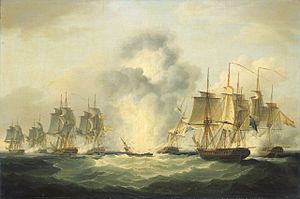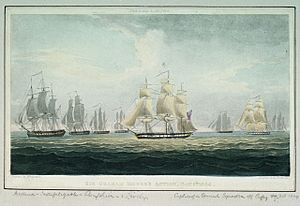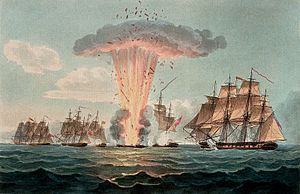Action of 5 October 1804 facts for kids
Lua error in Module:Coordinates at line 614: attempt to index field 'wikibase' (a nil value).
Quick facts for kids Anglo-Spanish War |
|||||||
|---|---|---|---|---|---|---|---|
| Part of the Napoleonic Wars | |||||||
 The action of 5 October 1804, Francis Sartorius |
|||||||
|
|||||||
| Belligerents | |||||||
| Commanders and leaders | |||||||
| Strength | |||||||
| 4 frigates | 4 frigates | ||||||
| Casualties and losses | |||||||
| 9 killed and wounded | 349 killed and wounded 600 captured 3 frigates captured 1 frigate destroyed |
||||||
The Battle of Cape Santa Maria was a naval fight that happened off the coast of Portugal. It took place on October 5, 1804. In this battle, a British group of ships led by Commodore Graham Moore fought and defeated a Spanish group of ships. The Spanish ships were commanded by Brigadier Don José de Bustamante y Guerra.
Contents
Why the Battle Happened
Spain had a secret agreement with France. Under this agreement, Spain had to pay France a large sum of money every year. This payment would continue until Spain declared war on Britain.
The British government found out about this secret agreement. They knew that Spain would likely declare war on them soon. They also knew that Spanish treasure ships, carrying lots of gold and silver, were expected to arrive in Cádiz. The British decided to send ships to stop them.
On August 9, 1804, Brigadier Bustamante sailed from Montevideo. He had four frigates loaded with gold, silver, and other valuable goods. On September 22, Admiral Cornwallis ordered Captain Graham Moore to intercept these Spanish ships. Moore's goal was to stop them peacefully if possible.
Moore's ship, the 44-gun frigate HMS Indefatigable, arrived near Cadiz on September 29. Other British frigates, HMS Lively, HMS Medusa, and HMS Amphion, joined him over the next few days. They patrolled the waters leading to Cádiz.
The Battle Begins
At dawn on October 5, the Spanish frigates saw the coast of Portugal. Around 7 a.m., they spotted the four British frigates. Bustamante quickly arranged his ships for battle. Within an hour, the British ships were in position, ready to fight. They were very close to the Spanish ships.
Commodore Moore, the British commander, sent an officer to the Spanish flagship, Medea. The officer explained that the British had orders to stop the Spanish ships. Bustamante refused to surrender.
Around 10 a.m., Moore ordered a warning shot to be fired in front of the Medea. Almost immediately, a full battle began. Within ten minutes, the magazine (where gunpowder was stored) of the Spanish ship Mercedes exploded. The ship was destroyed. Almost all of its 240 crew members died, with only about 40 surviving.
Within half an hour, two more Spanish ships, the Santa Clara and the Medea, surrendered. The Fama tried to escape, but the British ship Medusa quickly followed. Moore then ordered the faster Lively to chase the Fama. A few hours later, the Fama was also captured. The three captured Spanish frigates were taken to Gibraltar and then to England.
What Happened Next

The British stopping these Spanish treasure ships was a big event. It marked the end of an era for Spain. These were the last large shipments of gold and silver from Spain's colonies in the New World.
Normally, if ships were captured at sea, their value and cargo would go to the sailors who captured them. However, Britain and Spain were not officially at war when this battle happened. Because of this, a court decided that the money from the captured ships and cargo would go to the British Admiralty (the navy department), not directly to the captains and crews.
The four Spanish ships carried a huge amount of silver and gold coins. They also had gold bars, wool, tin, copper, and other goods. A lot of this treasure, including silver, copper, and tin, sank with the Mercedes. Still, the remaining ships and cargo were worth a lot of money. After some legal discussions, the British captains and crews received a special payment.
The captured Spanish ships were taken into the British Royal Navy. The Medea became HMS Iphigenia (later renamed HMS Imperieuse). The Santa Clara became HMS Leocadia, and the Fama became HMS Fama.
Spain officially declared war on Great Britain on December 14, 1804. Less than a year later, Spain suffered a huge defeat at the Battle of Trafalgar in October 1805.
Treasure Found Years Later
In March 2007, a company called Odyssey Marine Exploration found the wreck of the Mercedes. They recovered 17 tons of gold and silver from the seabed. The company said they found it in international waters. This meant they believed no country had a special claim to it.
However, the Spanish government disagreed. They called the Odyssey team "21st century pirates." In May 2007, Spain started legal action. They argued that the wreck was protected because it was a state-owned naval vessel. This meant it should not be disturbed or used for profit without permission. In June 2009, a court in the United States ruled in favor of Spain. The court ordered the treasure to be returned to Spain. The treasure was finally returned on February 25, 2012.
Ships in the Battle
Spain
- Medea: A 40-gun frigate, the main ship of Admiral Bustamante.
- Fama: A 34-gun frigate.
- Mercedes: A 36-gun frigate.
- Santa Clara: A 34-gun frigate.
Britain
- HMS Indefatigable: A 44-gun frigate, the main ship of Commodore Graham Moore.
- HMS Lively: A 38-gun frigate.
- HMS Amphion: A 32-gun frigate.
- HMS Medusa: A 32-gun frigate.
In Popular Stories
- The battle is shown in C. S. Forester's book Hornblower and the Hotspur. In the story, the hero Horatio Hornblower is with the British ships.
- In Patrick O'Brian's book Post Captain, Stephen Maturin helps find out about the Spanish ships. Captain Aubrey, commanding the Lively, captures the Santa Clara and the Fama.
- In Showell Styles's book Midshipman Quinn and Denise the Spy, the hero, Septimus Quinn, takes part in the battle.
- A comic book version of finding the treasure, The Treasure of the Black Swan, was made in 2018. It was written by a Spanish diplomat involved in the real-life legal fight, Guillermo Corral, and a Spanish graphic novelist, Paco Roca.
See also
 In Spanish: Batalla del cabo de Santa María (1804) para niños
In Spanish: Batalla del cabo de Santa María (1804) para niños


